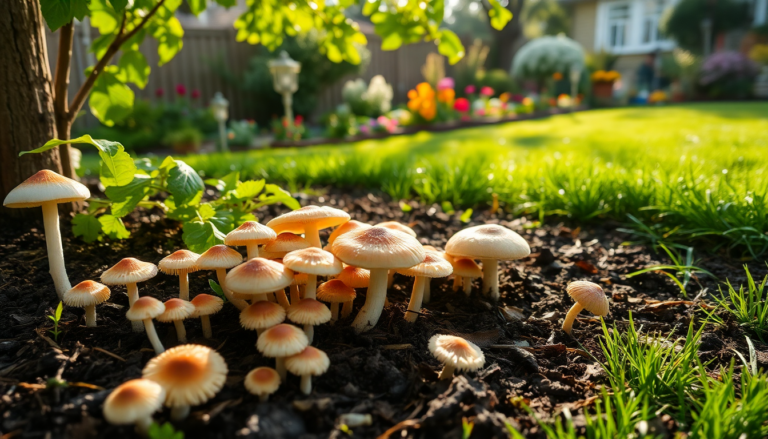Argomenti trattati
After a stretch of damp and humid weather, have you noticed mushrooms popping up in your yard or garden beds? While we can’t control Mother Nature, understanding how to manage and prevent mushrooms can make a real difference in the overall health and look of our outdoor spaces. Sure, mushrooms can indicate nutrient-rich soil, but their presence might also detract from your home’s curb appeal and hint at underlying issues like poor drainage, inadequate light exposure, or insufficient air circulation. Plus, some mushrooms can pose safety risks, especially for curious children and pets.
Why do mushrooms grow in your garden?
The journey of mushrooms starts with mycelium, a web of filaments hidden beneath the soil. This mycelial network only produces mushrooms when the conditions are just right—think moisture combined with shade. It’s fascinating to realize that what we see above ground is merely the fruiting body of a much larger organism lurking below. So, tackling mushroom growth is about more than just yanking them out; it involves understanding and adjusting the conditions that allow them to thrive.
Identifying where mushrooms flourish in your yard is your first step toward effective management. Typically, these fungi love moist, shaded spots. Once you pinpoint these areas, you can take proactive measures to treat them and prevent future outbreaks. The goal isn’t to eliminate the mycelium entirely—after all, it plays an important role in the ecosystem—but rather to create an environment that discourages mushroom growth.
Practical steps to control mushroom growth
Before you start removing mushrooms, it’s essential to gear up properly. Wearing gardening gloves is a smart move to avoid skin irritation from potentially toxic varieties. When you’re ready to remove a mushroom, use a trowel to dig underneath it, making sure to get as much of the fruiting body as possible without breaking it off at the stem. And remember, toss those mushrooms in a garbage bag—composting them could just lead to more mushrooms sprouting up!
Once you’ve cleared away the mushrooms, consider applying a diluted white vinegar solution to the area to deter future growth. This simple mix—one part vinegar to four parts water—can be sprayed directly onto the soil where the mushrooms were. But hold on, just removing the visible mushrooms may not be enough. Their presence could signal more significant issues in your yard.
Regular lawn maintenance is key. Keeping your grass trimmed short can help reduce the damp, shaded conditions that mushrooms love. Aim for a height of 2.5 to 3 inches for cool-season grasses, which will help discourage fungal growth.
Another important factor is managing organic matter. Mushrooms thrive on decaying materials, so raking up leaves and grass clippings is vital. If you’re already dealing with a mushroom problem, start by clearing away any excess organic debris before tackling the mushrooms themselves.
Also, take a look at your watering habits. Overwatering can create a perfect environment for mushrooms to thrive. A good rule of thumb is to give your lawn about 1 to 1.5 inches of water per week. Keep an eye on the weather and adjust your watering schedule based on rainfall or existing soil moisture to avoid soggy conditions.
Improving soil drainage and sunlight exposure
Soil compaction can also contribute to mushroom growth, as it limits water drainage. This compaction often results from foot traffic, mowing, and the weight of heavy, wet soil. To improve drainage, consider using a lawn aerator, which creates small holes in the soil to enhance airflow and reduce moisture retention.
Excessive shade is another culprit behind those soggy patches that mushrooms love. Trim back overhanging branches and dense shrubs that block sunlight from reaching your lawn. This not only helps to prevent mushrooms but also boosts the overall health of your grass.
While identifying mushroom species is best left to the experts, it’s good to familiarize yourself with common varieties you might find in your yard. Always remove mushrooms before they release spores, which can lead to more growth. You may encounter honey mushrooms, which are generally non-toxic, and more dangerous varieties like the death cap or amanita muscaria, which are highly toxic.
In conclusion, keeping your lawn healthy and free from unwanted mushrooms requires a blend of proactive measures, regular maintenance, and attention to the conditions that encourage their growth. By following these guidelines, you can ensure that your garden remains visually appealing and a safe haven for your family and pets.

